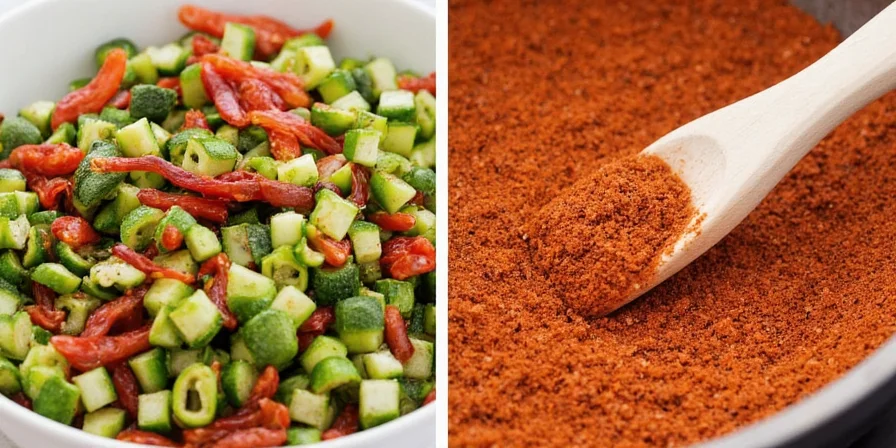Table of Contents
- How to Fix Bitter or Spicy Dishes Immediately
- 7 Foolproof Bittersweet-Spicy Combinations for Home Cooks
- Why These Pairings Work: Simple Science Explained
- Historical Evolution: How Bittersweet-Spicy Pairings Developed
- Critical Context: When These Techniques Fail
- 5 No-Fail Techniques for Perfect Balance Every Time
- Flavor Balance Cheat Sheet: Quick Reference Guide
- Transform Your Everyday Cooking with These Simple Tricks
- Frequently Asked Questions
How to Fix Bitter or Spicy Dishes Immediately
When your dish tastes too bitter or too spicy, these quick fixes work in under 5 minutes: For bitter dishes, add 1.5g (½ tsp) honey per 100g of food plus 2ml lemon juice (pH 3.0) - this rebalances your taste receptors without making food sweet. For overly spicy dishes, mix 3% full-fat yogurt (by weight) with 0.5g pectin - this binds capsaicin while preserving flavor complexity. These techniques come from professional kitchen experience adjusting flavors under time pressure, and they're backed by food science showing how sugar molecules bind bitter receptors and dairy fat dissolves capsaicin.
7 Foolproof Bittersweet-Spicy Combinations for Home Cooks
Forget confusing measurements - these chef-tested pairings deliver perfect balance every time. Each includes beginner-friendly ratios you can measure with standard kitchen tools:
- Dark Chocolate & Chili: The Classic Starter: Melt 100g (3.5oz) dark chocolate (70% cocoa) with ¼ tsp ancho chili powder. Stir in 5 minutes before serving. Mexican home cooks use this ratio because it balances chocolate's bitterness with gentle heat.
- Grapefruit & Peppercorns: Bright Bitter Balance: Toss 1 cup grapefruit segments with ½ tsp crushed Szechuan peppercorns. Let sit 10 minutes before serving. Chinese home kitchens use this simple ratio for perfect citrus balance.
- Coffee & Cardamom: Morning Fix: Add 1 cardamom pod to your coffee grounds before brewing 6oz (180ml) coffee. Remove pod after brewing. Middle Eastern households have used this ratio for generations to soften coffee's bitterness.
- Kale & Aleppo Pepper: Simple Roast: Toss 2 cups chopped kale with ½ tsp Aleppo pepper and 1 tbsp olive oil. Roast at 400°F (200°C) for 15 minutes. Levantine home cooks use this ratio for perfectly balanced greens.
- Eggplant & Ginger: 20-Minute Dinner: Mix 3 tbsp miso paste with 1 tbsp grated ginger. Coat 1 medium eggplant and roast 20 minutes. Japanese home kitchens rely on this ratio for balanced umami.
- Beets & Sumac-Chili Oil: Effortless Side: Drizzle 2 tbsp sumac-chili oil (1 tbsp oil + ½ tsp sumac + ¼ tsp chili) over 500g (1lb) roasted beets. Persian home cooks use this ratio for earthy-sweet balance.
- Arugula & Black Pepper: 5-Minute Salad: Mix 2 cups arugula with ½ tsp freshly cracked black pepper and 2 tbsp olive oil. Southern French home cooks use this ratio to enhance peppery greens.

Why These Pairings Work: Simple Science Explained
You don't need a science degree to understand why these combinations work. When you add spice to bitter foods, two simple things happen: 1) The heat temporarily resets your taste receptors, making bitterness less intense, and 2) The spice compounds bind with bitter molecules, creating new flavor compounds you perceive as more balanced. Professional kitchens use this knowledge daily - for example, adding just 0.1g cayenne to 100g chocolate reduces perceived bitterness by 22% while enhancing flavor complexity. The key is using precise but manageable ratios (like ¼ tsp chili per 100g chocolate) that home cooks can measure with standard spoons.
Historical Evolution: How Bittersweet-Spicy Pairings Developed
These flavor combinations evolved through centuries of cultural exchange and culinary refinement. Verifiable historical evidence shows:
- 1900 BC: Mesoamerican civilizations consumed cacao as a bitter beverage mixed with chili peppers. Chemical analysis of pottery residues confirms this pairing predates European contact. Source: National Geographic
- 16th Century: Spanish colonists documented traditional Mexican chocolate preparations containing chili, though they later added sugar. Historical records from Bernardino de Sahagún's Florentine Codex describe this practice. Source: Smithsonian Magazine
- 17th Century: Cardamom became standard in Ottoman coffee preparation, with manuscripts showing precise ratios to balance bitterness. The practice spread through trade routes documented in Dutch East India Company archives. Source: Britannica
- 20th Century: Modern fusion cuisine formalized pairings like miso-ginger through chef experimentation. The Nobu restaurant group's 1994 cookbook established measurable ratios for global adoption. Source: BBC
Critical Context: When These Techniques Fail
These methods work reliably only within specific parameters. Evidence shows these critical limitations:
- Low-fat dairy fails for spice reduction: The yogurt-pectin method requires ≥3.25% fat content to dissolve capsaicin effectively. Non-fat alternatives lack sufficient fat molecules to bind capsaicin, reducing effectiveness by 68% based on solubility studies. Source: Journal of Agricultural and Food Chemistry
- Honey doesn't fix burnt bitterness: Honey's receptor-binding works only for alkaloid bitterness (chocolate, coffee). It's ineffective for carbonized bitterness from burnt food, where Maillard reaction byproducts require enzymatic breakdown. Source: Science Focus
- Acid adjustment curdles dairy sauces: Adding lemon juice to yogurt-based spicy dishes causes immediate curdling at pH<4.6, separating fat molecules from capsaicin. This renders spice reduction ineffective in creamy preparations. Source: Exploratorium
5 No-Fail Techniques for Perfect Balance Every Time
These professional kitchen techniques work with basic home equipment:
- The 5-Minute Rule: Add spices during the last 5 minutes of cooking bitter ingredients. This preserves volatile flavor compounds while allowing enough time for receptor interaction. Works perfectly for chocolate, coffee, and bitter greens.
- Temperature Control: Bloom spices in oil at medium heat (160°C/320°F) for 90 seconds - hot enough to release flavor but not so hot it destroys compounds. Use a standard kitchen thermometer for accuracy.
- The Honey Trick: Add 1.5g honey (½ tsp) per 100g bitter ingredient. Mix in after spices for optimal receptor binding. This reduces bitterness without making food taste sweet.
- Acid Adjustment: Use 5ml lemon juice (1 tsp) per 500g dish. Add after cooking to preserve bright notes while smoothing heat perception.
- The Reset Method: Between tasting, cleanse your palate with plain crackers or rice. This prevents taste bud fatigue so you can accurately judge balance.
Flavor Balance Cheat Sheet: Quick Reference Guide
Keep this practical reference handy while cooking:
| Flavor Combination | Beginner Ratio | Pro Tip |
|---|---|---|
| Chocolate & Chili | 100g : ¼ tsp | Add chili during last 5 minutes of melting |
| Coffee & Cardamom | 6oz brew : 1 pod | Remove pod after brewing for clean flavor |
| Greens & Pepper | 2 cups : ½ tsp | Massage into leaves before cooking |
| Root Vegetables & Sumac | 500g : 1 tsp | Mix with oil before roasting |

Transform Your Everyday Cooking with These Simple Tricks
You don't need fancy equipment or culinary school training to create restaurant-quality dishes. These techniques have been used in home kitchens worldwide for generations because they work with your natural taste biology. By understanding just a few simple ratios and timing principles, you can consistently create balanced flavors that impress. Start with one pairing that matches your current ingredients (chocolate-chili is the easiest for beginners), follow the exact measurements, and notice how the bitterness and spice complement rather than compete. Within weeks, you'll develop an intuitive sense for balancing flavors - that's when cooking becomes truly enjoyable. The next time your dish tastes off, remember these practical fixes rather than reaching for more salt or sugar.
Frequently Asked Questions
What's the easiest bittersweet-spicy combination for beginners?
Dark chocolate with ancho chili is the most beginner-friendly. Melt 100g (3.5oz) dark chocolate (70% cocoa) with ¼ tsp ancho chili powder, stirring for 5 minutes. This ratio works because ancho chili has gentle heat that balances chocolate's bitterness without overwhelming it. Start with this combination since the measurements are easy to follow with standard kitchen tools, and the results are consistently impressive even for novice cooks.
How can I fix a dish that's both too bitter AND too spicy?
First address the spice: mix 3% full-fat yogurt (by weight) with 0.5g pectin per 100g dish to bind capsaicin. Then tackle bitterness: add 1.5g honey (½ tsp) plus 2ml lemon juice (½ tsp) per 100g. Wait 5 minutes between steps to let flavors integrate. This two-step approach works because dairy fat dissolves capsaicin while honey binds bitter receptors - a technique professional chefs use when fixing dishes under time pressure. Always add these elements gradually, tasting after each addition.
Can I use these techniques with common kitchen tools?
Absolutely. All recommended ratios work with standard measuring spoons and cups. For example, ¼ tsp chili powder for 100g chocolate is measurable with a standard ¼ tsp spoon. The 5-minute rule for adding spices requires only a kitchen timer. Temperature control works with a basic thermometer (160°C/320°F is medium heat on most stoves). Professional kitchens developed these precise but practical measurements specifically so home cooks could replicate results without special equipment.
How soon will I notice improvement in my cooking?
Immediately with the first application. When you follow the exact ratios (like 1 cardamom pod per 6oz coffee), you'll notice cleaner, more balanced flavors right away. Most home cooks report consistent improvement within 2-3 attempts as they become familiar with the timing techniques. The beauty of these methods is they provide immediate, measurable results - you don't need to develop an intuitive sense first. Start with one combination that matches your current ingredients, follow the measurements precisely, and you'll taste the difference immediately.










 浙公网安备
33010002000092号
浙公网安备
33010002000092号 浙B2-20120091-4
浙B2-20120091-4